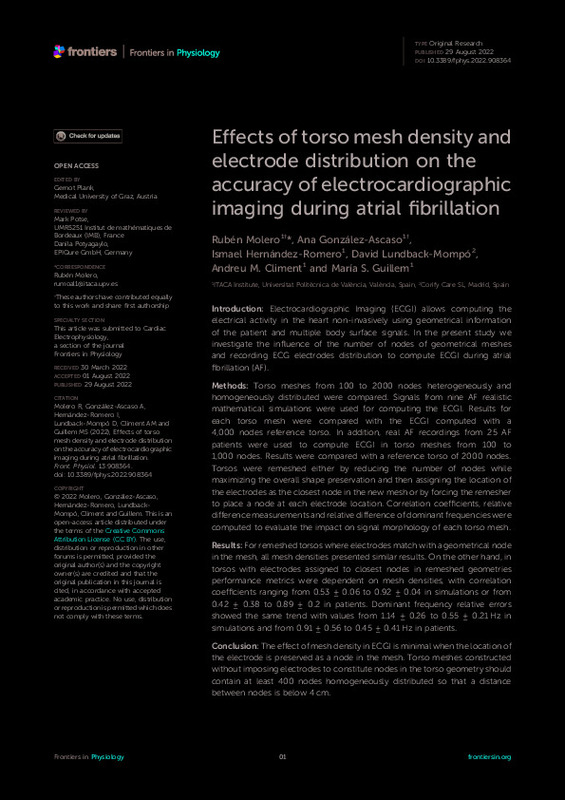JavaScript is disabled for your browser. Some features of this site may not work without it.
Buscar en RiuNet
Listar
Mi cuenta
Estadísticas
Ayuda RiuNet
Admin. UPV
Effects of torso mesh density and electrode distribution on the accuracy of electrocardiographic imaging during atrial fibrillation
Mostrar el registro sencillo del ítem
Ficheros en el ítem
| dc.contributor.author | Molero-Alabau, Rubén
|
es_ES |
| dc.contributor.author | Gonzalez-Ascaso, Ana
|
es_ES |
| dc.contributor.author | Hernández-Romero, Ismael
|
es_ES |
| dc.contributor.author | Lundbäck-Mompó, David
|
es_ES |
| dc.contributor.author | Andreu M. Climent
|
es_ES |
| dc.contributor.author | Guillem Sánchez, María Salud
|
es_ES |
| dc.date.accessioned | 2023-06-28T18:00:48Z | |
| dc.date.available | 2023-06-28T18:00:48Z | |
| dc.date.issued | 2022-08-29 | es_ES |
| dc.identifier.issn | 1664-042X | es_ES |
| dc.identifier.uri | http://hdl.handle.net/10251/194583 | |
| dc.description.abstract | [EN] Introduction: Electrocardiographic Imaging (ECGI) allows computing the electrical activity in the heart non-invasively using geometrical information of the patient and multiple body surface signals. In the present study we investigate the influence of the number of nodes of geometrical meshes and recording ECG electrodes distribution to compute ECGI during atrial fibrillation (AF).Methods: Torso meshes from 100 to 2000 nodes heterogeneously and homogeneously distributed were compared. Signals from nine AF realistic mathematical simulations were used for computing the ECGI. Results for each torso mesh were compared with the ECGI computed with a 4,000 nodes reference torso. In addition, real AF recordings from 25 AF patients were used to compute ECGI in torso meshes from 100 to 1,000 nodes. Results were compared with a reference torso of 2000 nodes. Torsos were remeshed either by reducing the number of nodes while maximizing the overall shape preservation and then assigning the location of the electrodes as the closest node in the new mesh or by forcing the remesher to place a node at each electrode location. Correlation coefficients, relative difference measurements and relative difference of dominant frequencies were computed to evaluate the impact on signal morphology of each torso mesh.Results: For remeshed torsos where electrodes match with a geometrical node in the mesh, all mesh densities presented similar results. On the other hand, in torsos with electrodes assigned to closest nodes in remeshed geometries performance metrics were dependent on mesh densities, with correlation coefficients ranging from 0.53 +/- 0.06 to 0.92 +/- 0.04 in simulations or from 0.42 +/- 0.38 to 0.89 +/- 0.2 in patients. Dominant frequency relative errors showed the same trend with values from 1.14 +/- 0.26 to 0.55 +/- 0.21 Hz in simulations and from 0.91 +/- 0.56 to 0.45 +/- 0.41 Hz in patients.Conclusion: The effect of mesh density in ECGI is minimal when the location of the electrode is preserved as a node in the mesh. Torso meshes constructed without imposing electrodes to constitute nodes in the torso geometry should contain at least 400 nodes homogeneously distributed so that a distance between nodes is below 4 cm. | es_ES |
| dc.description.sponsorship | This work was supported by: Instituto de Salud Carlos III, and Ministerio de Ciencia e Innovacion (supported by FEDER Fondo Europeo de Desarrollo Regional PI17/01106, PEJ2018003617 and RYC2018-024346-I), EIT Health (Activity code 220385, EIT Health is supported by EIT, a body of the European Union), Generalitat Valenciana Conselleria d'Educacio, Investigacio, Cultura i Esport (ACIF/2020/265) and Spanish Agencia Estatal de Investigacion (AEI), part of the Ministerio de Ciencia e Innovacion, reference PID2020-119364RB-I00. | es_ES |
| dc.language | Inglés | es_ES |
| dc.publisher | Frontiers Media SA | es_ES |
| dc.relation.ispartof | Frontiers in Physiology | es_ES |
| dc.rights | Reconocimiento (by) | es_ES |
| dc.subject | Electrocardiographic imaging | es_ES |
| dc.subject | Geometry | es_ES |
| dc.subject | Torso | es_ES |
| dc.subject | Atrial fibrillation | es_ES |
| dc.subject | Mesh density | es_ES |
| dc.subject.classification | TECNOLOGIA ELECTRONICA | es_ES |
| dc.title | Effects of torso mesh density and electrode distribution on the accuracy of electrocardiographic imaging during atrial fibrillation | es_ES |
| dc.type | Artículo | es_ES |
| dc.identifier.doi | 10.3389/fphys.2022.908364 | es_ES |
| dc.relation.projectID | info:eu-repo/grantAgreement/INSTITUTO DE SALUD CARLOS III//PI17%2F01106//ESTRATIFICACION Y TRATAMIENTO DE LA FIBRILACION AURICULAR BASADA EN LOS MECANISMOS DE PERPETUACION DE LA ARRITMIA/ | es_ES |
| dc.relation.projectID | info:eu-repo/grantAgreement/AEI/Plan Estatal de Investigación Científica y Técnica y de Innovación 2017-2020/PID2020-119364RB-I00/ES/DESARROLLO DE UNA HERRAMIENTA DE MAPEO PANORAMICO PARA LA EVALUACION DE SUSTRATOS ELECTRO-ESTRUCTURALES PARA GUIAR LA ABLACION DE LA FIBRILACION AURICULAR UTILIZANDO AI/ | es_ES |
| dc.relation.projectID | info:eu-repo/grantAgreement/AGENCIA ESTATAL DE INVESTIGACION//RYC2018-024346-I//AYUDA CONTRATO RAMON Y CAJAL-MARTINEZ CLIMENT/ | es_ES |
| dc.relation.projectID | info:eu-repo/grantAgreement/GENERALITAT VALENCIANA//ACIF%2F2020%2F265//AYUDA PREDOCTORAL GVA-MOLERO ALABAU. PROYECTO: ESTIMACION DE LA COMPLEJIDAD ELECTRICA AURICULAR DURANTE LA FIBRILACION AURICULAR/ | es_ES |
| dc.relation.projectID | info:eu-repo/grantAgreement/EIT Health//220385/ | es_ES |
| dc.relation.projectID | info:eu-repo/grantAgreement/MICINN//PEJ2018-003617/ | es_ES |
| dc.rights.accessRights | Abierto | es_ES |
| dc.contributor.affiliation | Universitat Politècnica de València. Escuela Técnica Superior de Ingenieros de Telecomunicación - Escola Tècnica Superior d'Enginyers de Telecomunicació | es_ES |
| dc.description.bibliographicCitation | Molero-Alabau, R.; Gonzalez-Ascaso, A.; Hernández-Romero, I.; Lundbäck-Mompó, D.; Andreu M. Climent; Guillem Sánchez, MS. (2022). Effects of torso mesh density and electrode distribution on the accuracy of electrocardiographic imaging during atrial fibrillation. Frontiers in Physiology. 13:1-10. https://doi.org/10.3389/fphys.2022.908364 | es_ES |
| dc.description.accrualMethod | S | es_ES |
| dc.relation.publisherversion | https://doi.org/10.3389/fphys.2022.908364 | es_ES |
| dc.description.upvformatpinicio | 1 | es_ES |
| dc.description.upvformatpfin | 10 | es_ES |
| dc.type.version | info:eu-repo/semantics/publishedVersion | es_ES |
| dc.description.volume | 13 | es_ES |
| dc.identifier.pmid | 36105286 | es_ES |
| dc.identifier.pmcid | PMC9465032 | es_ES |
| dc.relation.pasarela | S\477580 | es_ES |
| dc.contributor.funder | EIT Health | es_ES |
| dc.contributor.funder | GENERALITAT VALENCIANA | es_ES |
| dc.contributor.funder | INSTITUTO DE SALUD CARLOS III | es_ES |
| dc.contributor.funder | AGENCIA ESTATAL DE INVESTIGACION | es_ES |
| dc.contributor.funder | European Regional Development Fund | es_ES |
| dc.contributor.funder | Ministerio de Ciencia e Innovación | es_ES |








